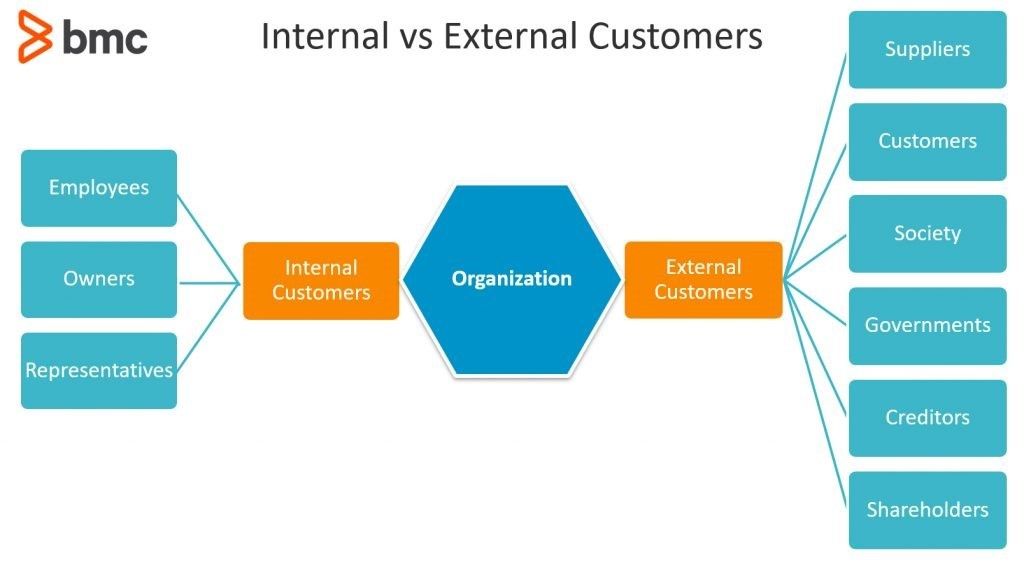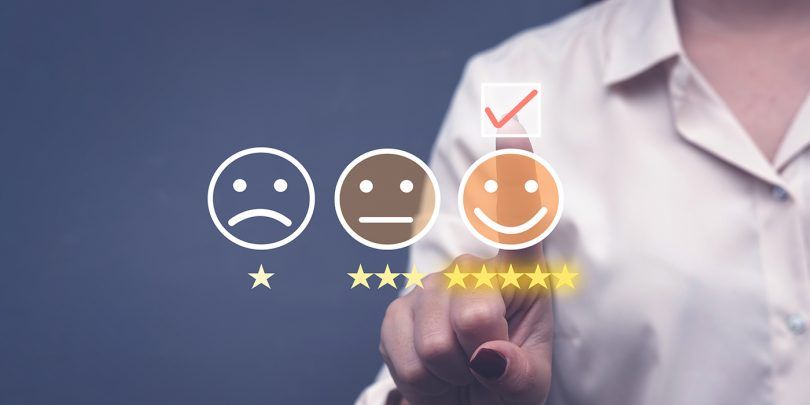| |
We’re all pretty clear on what a customer is, but sometimes it helps to clarify the overarching definition, especially as thinking evolves around providing a great customer experience to external and internal customers who might define experience in completely different terms. So, let’s explore the differences between external and internal customers.
- From an IT perspective, it’s often helpful to separate the types of customers you serve: you may have a help desk and a service desk, or maybe a service desk that serves both internal employees and public customers.
- From a customer service perspective, understanding the needs of your customers can help you clarify workflows and decide whether your company should distinguish between internal and external customers.

What is an external customer?
External customers are the people that pay for and use the products or services your company offers. When brainstorming problems and designing solutions, these customers are who you’re designing for.
To be clear, an external customer is a person who is not directly connected to your organization other than by purchasing your product or service. This customer could be a one-time purchaser or a person who’ve you worked with long-term and to whom you’ve provided add-ons or customization options. External customers are also known as “clients” or “accounts.”
The goals for your external customer can depend on your product or service, i.e., repeat purchasing, referrals, positive reviews, and otherwise supporting your company. You might follow up after-purchase—or during—to conduct formal or quick-pulse surveys. “The customer is always right” is generally the guiding principle when serving this group, and the revenue they generate is the lifeblood of your company. Without them, your company fails.
What is an internal customer?
Internal customers have a relationship with, and within, your company, either through employment or as partners who deliver your product or service to the end user, the external customer. Less obvious but certainly still significant, stakeholders and shareholders are also internal customers. All of these may or may not purchase your product or service.
Comparing internal and external customers
External customers have been inherent in business since people started making and selling products—a long time! The idea of an internal customer, however, is a more modern one. For instance, Six Sigma encourages identifying internal customers as a way of creating a more positive work environment.
That positive work environment includes things like kind and empathetic leadership, fair and equitable pay, comfortable working conditions, the latest technology, and so on. The thinking goes: the higher employee morale, the more those employees work with integrity and productivity. That morale can also come from the idea that they are contributing to something larger, which ripples out positively to improve how they work. One school of thought connects satisfied internal customers with happy external customers.
Beyond the feel-good psychology, though, using the term “internal customers” may have some tangible benefits. For teams who work with both internal and external customers, it can help them prioritize problems and timelines to improve inter-department communication. Treating everyone as a customer may also encourage employees to take each other just as seriously as they would take a referral or complaint from an external customer.
Do negative internal customer experiences affect external customers?
Once you determine that you’re going to address customers as internal and external, it’s easier to recognize how the former’s experience can affect the latter’s.
Case in point, if your internal customers have a role that faces external customers, such as in a call center, then it’s imperative that the systems those employees rely on for their jobs are resilient and function easily and effectively.
If outdated processes and antiquated tech frustrate your staff, that experience is likely replicated when your external customers seek assistance, so you get dual frustrations—not a great recipe for success. Delivering smooth, intuitive experiences for internal customers frees them to provide the same to your external customers.
Drawbacks of making each person a customer
Business experts and sociologists are aware of the inherent confusion in delineating internal and external customers. How do you apply “the customer is always right” to a coworker or colleague who isn’t on board with the new company philosophy or method?
The truth is you may not be able to, which is why some believe the term “internal customers” can dilute the urgency around external customers. This paradigm shift may actually promote more mediocre performance. If everyone is a customer, who is the most important? The answer should be the external customer.
CEOs find more success when they connect employees to external customers. It is more impactful to talk about how their product (medical devices, time management software, bicycle helmets, etc.) is valuable to the customers by saving their lives or improving their work than it is to compare how much money shareholders will get as a result.
Many employees in IT, customer service, and other customer-facing roles also support the “external customers only” mindset because it leads to better alignment across the organization. You’re all trying to serve the singular group of external customers, instead of the various internal clients that are spread across your company’s departments and related partners.
The Transcendent Customer Experience
One of the tenets of the Autonomous Digital Enterprise, the Transcendent Customer Experience (TCE), weighs external and internal customers as equally important. And it sees the external customer experience (CX) and internal, or employee, experience (EX) evolving to a future-state that gives customers what they want, when and where they want it, quickly and seamlessly. In many ways, that future state has been significantly fast-tracked, and CX and EX have almost blurred into one.
With the 2020 global pandemic putting so many brick and mortar businesses and on-site work arrangements on pause, CX and EX are increasingly being done online from cell phones, tablets, laptops, and an array of devices. To address this, many retailers, businesses, and employers have had to nimbly pivot their thinking, and their systems, to catch up—whether that means supporting online ordering and contactless delivery or telemedicine, or helping staff set up high-speed internet, VPN, and conferencing tools to do their jobs at home.
Businesses that immediately shifted gears to adapt to these new processes have been able to keep their internal and external customers happy.
Driven by a marriage of data and journey analytics that anticipate and deliver proactive instead of reactive experiences, TCE ascribes to the idea of taking the experience to the customers—wherever they happen to be. Merging human elements with technology—specifically artificial intelligence (AI) and machine learning (ML)—has enabled a new era of mobile-first and do-it-yourself solutions that empower external and internal customers to architect the services and solutions they need with a simple swipe or tap.
That newfound speed and convenience will no doubt have far-reaching implications for both internal and external customers as they chart a course toward the future.
Related reading
- BMC Business of IT Blog
- BMC Service Management Blog
- What is Employee Experience Management?
- What Is EXTech? The Newest Way to Improve the Employee Experience
- Using Customer Satisfaction (CSAT) as a Service Desk Metric
These postings are my own and do not necessarily represent BMC's position, strategies, or opinion.
See an error or have a suggestion? Please let us know by emailing blogs@bmc.com.

